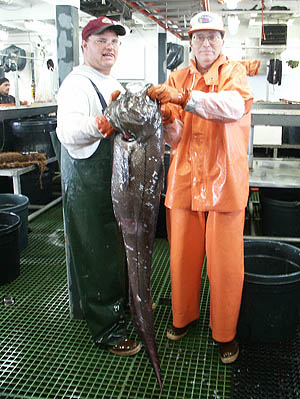| |

Figure 1. A giant grenadier caught during the 2004 AFSC sablefish longline survey.
|
Groundfish Assessment Program
Grenadiers in Alaska
Grenadiers (family Macrouridae) are deep-sea fishes
related to hakes and cods that occur worldwide in all oceans. Also known
as rattails, they are especially abundant in waters of the continental
slope, but some species are found at abyssal depths. At least seven
species of grenadier are known to occur in Alaskan waters, but only
three are commonly found at depths shallow enough to be encountered in
commercial fishing operations or in fishery surveys: giant grenadier (Albatrossia
pectoralis) (Fig. 1), Pacific grenadier (Coryphaenoides acrolepis),
and popeye grenadier (Coryphaenoides cinereus). Of these, giant
grenadier has the shallowest depth distribution and the largest apparent
biomass, and hence is by far the most frequent grenadier caught in Alaska.
For management purposes, grenadiers in Alaska are
presently considered unspecified species in both the Gulf of Alaska and
the Bering Sea/Aleutian Islands Fishery Management Plans. This means
that for these fish, there are no limitations on catch or retention, no
reporting requirements, no official tracking of catch by management, and
that no stock assessments have been done. However, because of concern
that grenadiers may in the future be moved to a specified status and
require a formal stock assessment, and also because of the importance of
these fish in the continental slope ecosystem, work began in 2004 to
assemble data on grenadiers that would be necessary in future stock
assessments. The work consisted of analysis of existing survey and
fishery information on grenadiers and initial field observations and
sample collections concerning fecundity and maturity of giant grenadier.
Information from AFSC trawl and longline surveys
shows that giant grenadiers comprise virtually all the grenadiers found
in waters less than 800 m depth; Pacific and popeye grenadier only
become common at depths greater than 800 m. Furthermore, the surveys
indicate that giant grenadier are the most abundant fish on the
continental slope at depths of 400-1,000 m in all surveyed areas of
Alaska except the eastern Gulf of Alaska. As such, they have a
significant role in the slope ecosystem and are important predators in
this habitat. Surveys also indicate that male and female giant grenadier
have different depth distributions. Nearly all the fish at depths of
less than 800 m are females, whereas males are found in deeper waters.
Although there has been little or no directed fishing for grenadiers
in Alaska, substantial numbers are taken as bycatch and discarded in the
sablefish and Greenland turbot longline fisheries. None of the discarded
grenadiers survive, as the pressure difference experienced by the fish when they are
brought to the surface from deep water invariably causes death. In the
past, fisheries observers have not identified grenadiers to species.
However, as the longline fisheries operate mostly in depths less than
800 m, it can be surmised that giant grenadier comprise nearly all of
the grenadier taken. Based on observer data, estimated annual catches of
giant grenadier in Alaska may have ranged between 13,000 and 21,000
metric tons (t) in the years 1997-2001. If true, these estimates
indicate that more giant grenadier were caught and discarded in Alaska
than the amount of sablefish that was taken during these years.
The large biomass of giant grenadier in Alaska may be
able to support this level of catch, but the reported longevity and slow
growth of this species makes it susceptible to overfishing. Furthermore,
a high proportion of the catch is likely female because mostly female
giant grenadier live at the depths where the commercial fishery
operates. Disproportionate removal of females by the fishery could put
stocks of giant grenadier at greater risk. One possible mitigating
factor that may protect giant grenadier from overfishing is that a
substantial portion of its population may inhabit depths greater than
1,000 m, where they are presently safe from any fishing pressure. These
deep waters could act as a de facto reserve to replenish giant grenadier
removed by the fishery in shallower water. Further analyses of fishery
and survey data for giant grenadier are needed, as well as additional
biological studies, to better determine the population dynamics of this species.
To obtain more biological information on this
species, female giant grenadier were sampled for spawning condition,
sexual maturity, and fecundity during one leg of the 2004 AFSC sablefish
longline survey in the Gulf of Alaska. Visual examination of the ovaries
suggested that the overall population in this region may have a very
protracted spawning period and that spawning is probably not a
synchronous event. Individual fish were in various stages of ovarian
development; some were ripe and spawning, whereas others were in very
early stages. Determination of size at 50% sexual maturity was
unsuccessful, as very few fish were found to be immature. To obtain the
complete range of fish sizes needed for a size of maturity analysis,
sampling with an alternative gear such as trawls will likely be
necessary. All ovaries were preserved, and those in an advanced
developmental stage will be used to determine estimates of fecundity.
By David Clausen
>>>continued
 |

|
Quarterly sidebar
AFSC Quarterly Research Reports April-June 2005
Contents
Feature
ABL Reports
NMML Reports
RACE Reports
REFM Reports
Items
Quarterly Index
Quarterly Home
|

